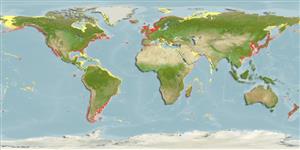Common names from other countries
Environment: milieu / climate zone / depth range / distribution range
экология
; солоноватоводный; пределы глубины 3 - 58 m (Ref. 112705). Tropical
Cosmopolitan. Tropical to polar.
Length at first maturity / Size / Вес / Возраст
Maturity: Lm ? range ? - ? cm Max length : 6.0 cm TL самец/пол неопределен; (Ref. 7882)
Species' maximum length from the Belgian part of the North Sea (Ref. 7882). Tubiculous (Ref. 112705). Found in estuarine and inshore areas (Ref. 96352) along the coastal zone in almost all sediment types from fine to coarse sand with mud content of 0 to 90% (Refs. 2780, 7882, 96352). Associated with organic pollutants (Ref. 96352). Tube-building species (Ref. 96377). A surface-deposit microvore that feeds on organic detritus (Ref. 96352).
Life cycle and mating behavior
половая зрелость | размножение | нерест | икра | Fecundity | личинки
Members of the class Polychaeta are mostly gonochoric (sexual). Mating: Females produce a pheromone attracting and signalling the males to shed sperm which in turn stimulates females to shed eggs, this behavior is known as swarming. Gametes are spawned through the metanephridia or body wall rupturing (termed as "epitoky", wherein a pelagic, reproductive individual, "epitoke", is formed from a benthic, nonreproductive individual, "atoke"). After fertilization, most eggs become planktonic; although some are retained in the worm tubes or burrowed in jelly masses attached to the tubes (egg brooders). Life Cycle: Eggs develop into trocophore larva, which later metamorph into juvenile stage (body lengthened), and later develop into adults.
Основная ссылка
ссылки | координатор | соавторы
Salazar-Vallejo, S.I. and M.H. Londoño-Mesa. 2004. (Ref. 8159)
Статус Красного Списка МСОП (Ref. 130435)
Статус СИТЕС (Ref. 108899)
Not Evaluated
Not Evaluated
Использование человеком
| FishSource |
инструменты
дополнительная информация
Возраст/РазмерыростЗависимость между длиной и массой телаЗависимость между длинамиморфологияличинкичисленность
ресурсы в Интернет
Estimates based on models
Категория цены
Unknown.
